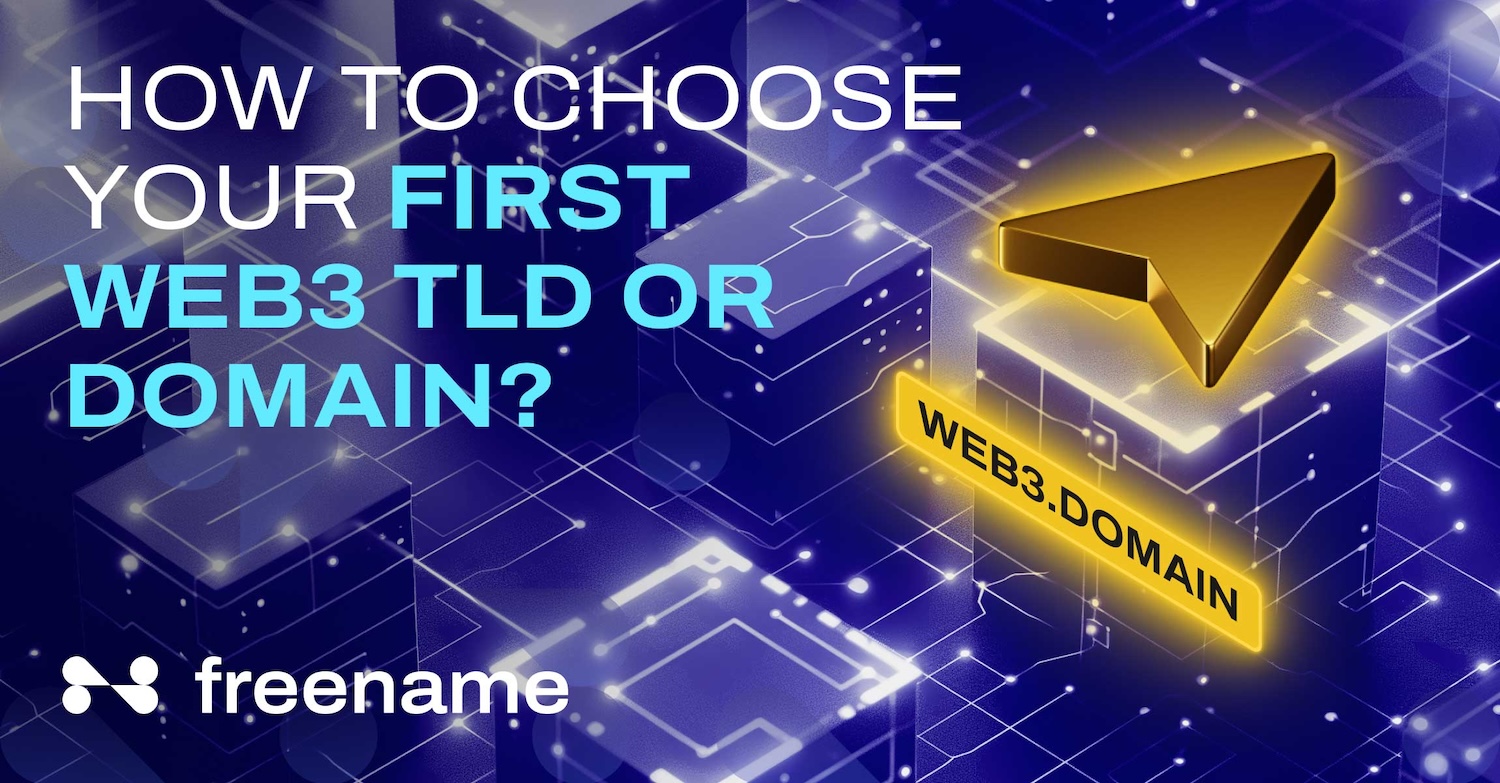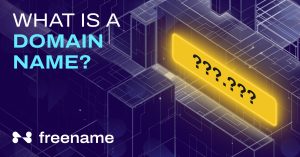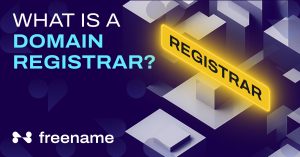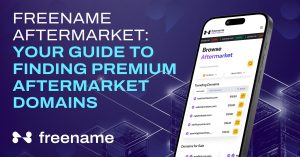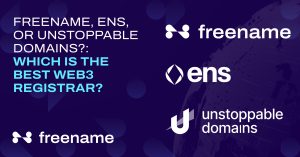How To Choose Your First Web3 name for TLDs or Domains
The Internet has officially entered a new phase with attributes like decentralization, user-controlled digital identities, fool-proof security, interoperability, and much more. Operated on blockchain technology, Web3 names and domains give access to these attributes. With a Web3 domain, you can enjoy seamless interactions and own and manage your digital presence autonomously.
Businesses and individuals have been switching to the Web3 space to protect their websites and other digital assets from cyber threats, ensuring privacy and data integrity. With decentralization, they can provide a safe, transparent, and 1:1 environment for improved B2B and B2C interactions, fostering trust and loyalty.
Considering privacy and data security, integrating Web3 into business strategies becomes essential for staying ahead in the digital landscape. For this purpose, you’ll need Web3 domains to capture your target audience and establish your brand.
So, do you want to learn how you can choose your first Web3 name for TLD or domains? If so, this post has all the answers. Let’s dive in.
Understanding Web3 Domains
Also known as decentralized domains, Web3 domains function just like traditional URLs do: they replace complex and hard-to-remember cryptic addresses attached to your digital properties. With Web3 domains, you can own and manage your online presence and surf through the decentralized web without any threats of cyberattacks or other malicious practices.
Web3 Domain Advantages
Compared to Web2 domains, Web3 domains are more dynamic in nature. They offer several benefits to ensure a highly user-centric and efficient internet experience, for example:
- Enhanced security through blockchain’s immutable ledger,
- Increased privacy with user-controlled data,
- Resistance to censorship by eliminating central points of control.
- Seamless integration with decentralized applications (dApps) and services
Key Differences Between Web3 and Web2 Domains
| Feature | Web3 Domains | Web2 Domains |
| Control | Decentralized, user-controlled | Centralized, controlled by central servers |
| Security | High, due to blockchain encryption | Moderate, vulnerable to DNS attacks |
| Censorship | Resistant to censorship | Subject to censorship by ICANN |
| Privacy | Enhanced user data control | Limited; data often collected by third parties |
| Integration | Seamless with dApps and blockchain services | Limited to traditional web services |
| Ownership | Permanent, as long as blockchain exists | Requires periodic renewal |
| Cost | Affordable due to the availability of low-cost TLDs | Expensive due to limited TLDs |
| Income Potential | High, due to a lot of room in the Web3 space | Low, as the Webspace has become saturated. |
Levels in Domain Naming
Domain naming has two levels: a top-level domain (TLD) and a second-level domain (SLD). Understanding them is crucial in choosing a brandable and marketable Web3 domain name for your business or digital assets.
TLDs
Top-level domains are web extensions that mostly come after the (dot). For example, .com or .org. are top-level domains used by a large number of web2 domains. However, in Web3, there is a wider variety to choose from, or you can even create and register your own TLD.
In the Web3 ecosystem, TLDs are spaces operated on different blockchain networks. Users can register their domains with a TLD to access the features of that particular blockchain.
SLDs
Secon-level domains represent the core name. Mostly, SLD is a combination of letters (words or phrases) that come before the (dot). In traditional domains, SLDs represent the name of the business, niche-specific keywords, or popular search phrases.
Using TLD and SLD for Your Business
In a domain name, “contentmarketingservices.com”, the word contentmarketingservices is a second-level domain name registered with the .com TLD. However, this is not a rule of thumb for Web3 domains.
- An ideal situation is to pick a TLD (and become a registrar) that represents your niche, such as .gaming, .marketing, .finance, or .floordesigns. This would give you an opportunity to earn royalties whenever any SLD is registered under your TLD.
- Alternatively, you can choose an SLD and register it with popular TLDs like .metaverse, .sol, .eth, and .freename, etc.
Common Web3 TLD examples include .metaverse, .eth, .moon, .chain, .airdrop, .young, .free, .xxx, .layer, .hodl, .lambo, .token, etc.
Reasons to Own a Web3 TLD
Branding Opportunities
To stand out in a decentralized webspace, you need a unique and memorable domain name, and owning a Web3 TLD gives you that edge. Not only does a decentralized TLD enhance brand visibility, but it also adds to the credibility that most users look for.
The emerging Web3 ecosystem has greater transformative potential, especially for aspiring entrepreneurs, artists, content creators, developers, and other professionals. They must leverage Web3 TLDs to differentiate themselves from similar businesses and build a strong digital presence.
Potential for Royalties
Investors can buy Web3 TLDs to generate revenue by selling subdomains. This is the easiest way to create a passive income stream. Other users or companies may purchase subdomains under the primary TLD. In return, the TLD owner gets a share of the transaction fees or royalties.
Unified Web3 Identity
Blockchain users can also consolidate their digital identity using a single Web3 TLD across a wide variety of dApps and decentralized platforms. This means you can link your TLD to your blockchain wallet, NFTs, metaverse real estate, games, and other dApps.
Using a unified identity, you can:
- Simplify online interactions
- Enhance user experience
- Ensure consistent branding and reputation management
- Foster greater trust and recognition
Choosing the Best Web3 TLD
When selecting the best TLD for your website, you should bear the following factors in mind.
- Niche relevance: Choose a TLD related to your specific use case. For example, .airdrop is a Web3 site intended for crypto airdrops.
- Distinctiveness and memorability: A unique Web3 TLD can help you create a memorable domain name for your target audience and earn royalties when other users register under it. For this purpose, Freename is a platform that offers affordable Web3 TLDs and provides SLD registration services.
- Market targeting: For products meant for specific regions or territories, a TLD like .cc is a preferable option for targeting the audience. You can create a regional Web3 TLD to better target your audience, e.g., .nyk, .california, .alberta, etc.
- SEO: One of the major differences between Web2 and Web3 websites is the way SEO works. The SEO focus in Web3 TLDs should be on project simplification and brand authority. Therefore, it is important to choose a simple domain name that stays relevant to your brand and business objectives.
Popular TLD Options and Their Uses
| TLDs | Uses |
| .eth | Allow users to simplify their wallet addressesAllows integration with various decentralized applications (dApps) within the Ethereum ecosystem. |
| .crypto | Used for creating human-readable addresses for cryptocurrency walletsFacilitates easier transactions and paymentsProvides censorship-resistant websites and domains |
| .dao | Ideal for decentralized autonomous organizations (DAOs)Provide a clear and recognizable domain for DAO-related projects and communities. |
| .nft | Tailored for the burgeoning NFT (non-fungible token) marketUsed by artists, collectors, and platforms to showcase and trade digital art and collectibles. |
| .x | Offers a versatile option for various blockchain-based projects, including decentralized finance (DeFi), gaming, and other innovative Web3 applications. |
| .anom | Ideal for projects focused on privacy and anonymity, Provides a domain for services and applications that prioritize user privacy and data protection. |
| .gaming | Tailored for the gaming industryUsed by gaming platforms, developers, and communities to create decentralized gaming experiences and showcase gaming-related content. |
| .blockchain | Suitable for blockchain-focused projects, Provides a clear and professional domain for companies and initiatives in the blockchain industry. |
| .dapp | Specifically designed for decentralized applicationsUsed by developers and platforms to promote and host their dApps. |
| .wallet | Focused on cryptocurrency wallets,Offers a secure and easy-to-remember domain for wallet services and users. |
TLDs with High Potential
While choosing your first Web3 name for TLD or domains, make sure it has a better value proposition than others. Some examples include:
- .metaverse: For metaverse platforms.
- .token: For designating tokens associated profiles.
- .hodl: For hold on your dear life.
- .wallet: For a wallet address.
- .airdrop: For airdrop purposes.
- .freename: For domain minting purposes
These domains have different attributes, as discussed below:
- Functionality: Each of the above TLDs serves different purposes.
- High potential: These domains have substantial potential to generate high profits in the future.
- Use cases: You can find dApps and use cases associated with each of the above domains.
- Influence: These extensions can be directly associated with industry leaders and influencers who can play a big role in Web3 development.
- Worth minting: The above domains can be minted on different blockchains. You can mint the .freename TLD on Polygon, Binance Smart Chain (BSC), Solana, Base, and others.
Best Practices for Creating Your Web3 Name
Now that you’ve learned the basics of choosing the right Web3 domain, it’s time to create your domain name. Follow these best practices:
1. Keep It Simple
Choose a domain name that’s not too long or too hard to spell. Also, consider adding an emoji with your domain name to make it more appealing and memorable.
2. Choose the Optimal Length and Pricing
Clear and concise domain names with an average length between 3 – 8 characters have higher chances of getting organic traffic. Domain names with one word are more in demand, and those with nouns get more traffic.
What if the price is too high? Consider adding a few numbers or a unique word at the end.
3. Keep it Consistent Across Platforms
Choose a Web3 domain name that is consistent with your social channels (e.g., X, Discord, Email, etc.). You can use your username in your Web3 domain name to keep things simpler.
4. Start Strong
Remember that the ideal domain name does not exist. It’s you who make it one, with your efforts, of course. So, instead of spending hours on finding the perfect domain name, choose something relevant (that meets your budget) and start yield farming or shilling NFTs.
It’s more about securing your seats than naming them for the journey ahead!
Advantages of Web3 Domains
There’s more to Web3 domains than security, privacy, and censorship resilience. Let’s take a look at some of the most exciting benefits of Web3 domains:
Permanent Ownership
Web3 domains give complete ownership to their owner. You can use your Web3 domains for any purpose without having to register or pay activation fees on other platforms. Plus, you have all the propriety rights of the data linked with the domain.
One-time purchase
Unlike Web2 domains, Web3 domains don’t compel you to pay renewal or hosting fees time and again. For example, if you buy Freename domains, you only have a one-time purchase fee.
Multi-Utility as NFT Domains
The good thing about Web3 domains is that you can use them in any way. For example, you can use your Web3 domain as an NFT domain. It’s not merely a website address; you can collect your NFTs in one place, controlling them using a single domain name.
Integration with Decentralized Applications
Web3 domains can be integrated simultaneously with thousands of dApps operating on a particular blockchain. For example, a .eth can be integrated with 4000+ dApps on the Ethereum blockchain without third-party protocols.
Step-by-Step Guide to Registering a Web3 Domain on Freename
- Detailed Registration Process
- Tips for a Smooth Registration
The registration process is quick and straightforward:
Step 1: Register with Freename

- Simply visit Freename.io
- Go to the “Login” option available at the top right corner.
- When the next window appears, scroll down and click on the “Sign up” tab. You also have the option to “Sign in with Google”.
- Provide your personal information to get registered.
Step 2: Choose and Register the Web3 Domain
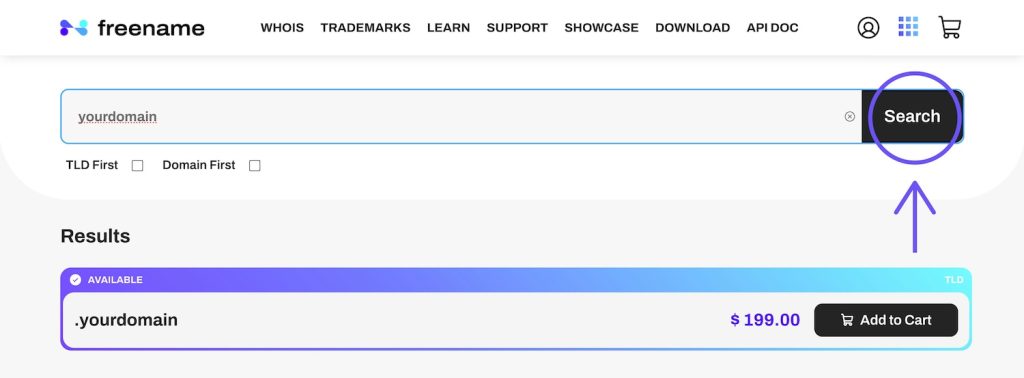
- After creating your account, go to the Freename Explorer and start searching for the relevant domains.
- Type the domain name in the search bar to review multiple domain name options and their pricing.
- Choose the domain as per your requirement and press “Buy”.
- You will land on the checkout page. Make the payment.
- The domain will appear in your account in a few moments. If it’s taking a long time, refresh the page.
Tips for Smooth Registration
- For smooth registration on Freename, start by searching domain names before getting yourself registered. In this case, when you press the Buy button, Freename will first take you to the Signup page to become its member.
- Make sure your wallet has sufficient cryptocurrency to pick the right domain name from Freename.
- You can use Freename to mint your Web3 domains as well. With Freename, you can mint on Base, Solana, Polygon, Binance, and more. Have enough cryptocurrency in your wallet to cover the cost of minting.

